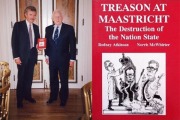INTRODUCTION BY FREENATIONS
We are pleased to publish this summary, by Sonya Jay Porter, of the legal systems in England before the Norman invasion, before the rebellion of the Barons against King John (and his supporter the Pope) and the freedoms guaranteed by Magna Carta. Now that we are facing a future without the imperial impositions of another continental power, the EU, it is worth recalling the systems of law which are the foundation of an English and hence largely a British sense of justice and the rule of law. That sense springs from local courts, the common law and case law where the grievances of the people are addressed and form precedents for “free men” – and not from bowing to top down, King/State imposed statute – and certainly not the imposed order of a foreign sovereignty like the EU.
The ruthless suppressions attempted by William the Conqueror, by King John, by Charles 1, by bloody Mary, by the consistent claim of the “divine right of Kings” and the repeated centralizations of power were largely overcome – until the world wars of the twentieth century and the constitutional surrender to EU rule in 1973. Now we are breaking free once again from oppressive European autocracy we have the opportunity to re-discover our former freedoms, laws and legal systems. I note that Martin Howe QC and two others have just proposed a new (domestic) “International Treaty Court” to restore British legal supremacy – ensuring sovereign freedom from the European Court. The British passport no longer bears the words “European Union”. At last we can see the light at the end of this miserable, dark tunnel! The road could be hard but freedom and prosperity were never built by easy compromise.
SONYA JAY PORTER:
Whether our current Parliament proves to be the last democratic Parliament before the United Kingdom’s governance is handed over to what will eventually become a European State, is still to be decided. Should this happen, Westminster would become little more than a local council and it would be the end of a Parliament which is considered to have been established during the 13th century but whose roots go back some 800 years before that.
As we know, the Romans occupied much of Britain for about 400 years and finally left during the 5th century to defend their own territory. For some time the Angles, Saxons, Jutes and other Germanic tribes had raided the coasts of Britain but then took the chance to invade the now defenceless and depopulated country to establish small kingdoms of their own. What is less known is that they brought with them their traditions of Folcmoots and the Witan and by the 7th century these had been established in the southern kingdoms of the Jutes and Anglo-Saxons.
Folcmoots were gatherings of local people who made decisions for their area on everything from contracts to judicial matters and were also councils of war. The Witan or ‘Wise Men’ was an assembly composed of noblemen, both secular and ecclesiastic, and met at a Witengemot, meeting or council, to give advice to the King but only when called upon to do so. However, at this time the Witan could not frame laws but only assent to those already decided upon by the King. But at least the Anglo-Saxon Kings were not dictators and realised that they could not govern their territories without the local support of these powerful men of the Witan.
It was the very beginning of a parliament as we know it today.
After the reintroduction of Christianity at the end of the 6th century, Law Codes were established in Kent, Mercia and in Wessex — the kingdom which at times covered what are now the counties from Kent to Devon and which in 937 melded the small Germanic kingdoms into the nation of England.
King Aethelberht of Kent (601 – 604), which was originally settled by the Jutes, became the first ruler both to convert to Christianity and, impressed by Roman law, to draw up to a Law Code which he did with the help of the Bishops of London and Wi[ta]nchester. This was based on local customs and instituted many new secular laws but also established the legal position of the clergy.
In 755 the Anglo-Saxon King Offa (757-796) of Mercia which was situated between Wales and East Anglia, next produced a Law Code based not only on King Ine’s Code but also on the old British Celtic customs and regulations.
While later Anglo Saxon Kings and also King Canute, both created new laws and added to Ine’s Code, that of King Alfred (The Great) of Wessex (871 – 899) is probably the largest and best known. He not only appended to his laws (or Dooms) those of Kings Ine and Offa which he thought suitable, but also attempted to blend old Celtic and Germanic customs together with the principles of the Mosaic and Christian laws.
This then became the foundation for our Common Law.
Although Shires later spread throughout Anglo-Saxon England, it is thought to have been during the reign of King Alfred that they were created as administrative areas within the kingdom and then smaller areas, termed Hundreds established within the Shires. These were ruled, under the King, by Ealdormen who were responsible for law and order and for providing justice. Both the Shires and the Hundreds had their own courts (the earlier Folkmoots) which were run by local dignitaries. The Hundred Courts, which met every four weeks, dealt with petty crime in their own area, while the Shire Courts, which met twice a year and were overseen by an Agent of the King and dealt with more serious crime within the Shire as a whole. These courts also allocated the gold which had been collected as tax by the ‘shire-reeve’ or peace officer. As burhs (boroughs or fortified towns) were gradually built during King Alfred’s reign, similar courts, held three times a year, were also founded within them and this system existed until this whole structure of local government was replaced in 1889 by the introduction of county councils.
The Shire Courts were held in the open air, using different locations for its meetings, as did the gatherings of the King’s Witan. However, it was the King himself who determined the Witan’s meeting times, the three main ones being held at Christmas, Easter and Whitsuntide. These then became the origin of the Courts of Assize, periodic courts of justice held around England and Wales until 1972 when they were replaced by a single permanent Crown Court.
During King Alfred’s reign, the duties of the Witan were extended to discussion of such things as taxation, defence and foreign policy. But before the Norman Conquest of 1066 and the imposition of primogeniture, the Witan’s greatest responsibility was that of electing the next King.
When William, Duke of Normandy, took the English throne in 1066 he introduced harsh laws to control his new subjects but did keep many which pertained to local customs and regulations. He also retained a smaller Witan with fewer duties which was then called the Curia Regis or King’s Council. A larger group of noble advisers was then formed, known as the Magnum Concilium or Great Council which formed the basis of the modern House of Lords.
However, during the next 150 years William I and his descendants took more and more power to themselves under their perceived Divine Right of Kings which resulted in a rebellion by the Barons and the signing by King John of the Magna Carta in 1215. For the first time in history, this declared the sovereign to be subject to the rule of law and documented the liberties held by ‘free men’. While not perfect, this Great Charter did provide the foundation for individual rights in Britain and elsewhere which have lasted until today.
Unfortunately the spirit of the Charter was later broken which resulted in more rebellions by the Barons and people and it was not until 1265 that a more representative Parliament was assembled by Simon de Montfort, the revolutionary Earl of Leicester who at that time was ruling England in place of the imprisoned King Henry III. He summoned not only lay magnates but two knights from each county and two citizens from each town and four men from each of the Cinque Ports. Although in 1295 a ‘Model Parliament’ was called by King Edward I and is said to be the model for later Parliaments, it is Simon de Montfort’s Parliament of 1265 which is usually regarded as being the first English Parliament and Simon de Montfort himself is often regarded as the founder of the House of Commons.
Indeed, in 1965 the Parliament of the United Kingdom presented a loyal address to Queen Elizabeth II to mark the 700th anniversary of Simon de Montfort’s Parliament.
But perhaps during this century the Sovereign, the House of Lords and the House of Commons, if they still exist, might look back to the year 450 and also celebrate the Anglo-Saxons and others who brought to this country the very traditions from which the British sense of democracy has grown over the centuries.
The Moot and Witan https://www.parliament.uk/about/living-heritage/evolutionofparliament/originsofparliament/birthofparliament/overview/origins/
King Aethelberht of Kent — Law Code https://everything.explained.today/Law_of_%C3%86thelberht/
King Ine — Law Code https://thehistoryofengland.co.uk/resource/selected-laws-of-ine-688-695/
King Alfred — Law Code https://earlyenglishlaws.ac.uk/laws/texts/af/
Shires and Hundred Courts https://en.wikipedia.org/wiki/Shire_court
Curia Regis or King’s Council https://www.britannica.com/topic/curia-medieval-European-court#ref257275
Magnum Concilium or Great council https://www.parliament.uk/about/living-heritage/evolutionofparliament/originsofparliament/birthofparliament/overview/origins/
Magna Carta https://www.britannica.com/topic/Magna-Carta
Simon de Montfort Parliament 1265 https://history.blog.gov.uk/2015/01/20/simon-de-montforts-1265-parliament/
Model Parliament 1295 https://www.britannica.com/topic/Model-Parliament


















